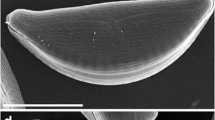Summary
Cells ofMicrasterias denticulata Bréb. at the stage of secondary wall formation have been studied by freeze-etching. It was found that the plasma membrane exhibits oval areas in which arrays of membrane particles occur. These particles form “rosettes” which are arranged in a hexagonally ordered lattice with a center to center spacing of ∼ 25 nm. Nearly the same periodicities can be found between microfibrils. It is concluded that the “rosettes” probably together with the thickened area of the plasma membrane below them represent the apparatus for the production and orientation of microfibrils. The hypothesis suggesting the incorporation of “membrane templates” functional in microfibril formation, originally advanced byKiermayer andDobberstein (1973) has received further support.
Similar content being viewed by others
References
Dobberstein, Beatrix, Kiermayer, O., 1972: Das Auftreten eines besonderen Typs von Golgivesikeln wÄhrend der SekundÄrwandbildung vonMicrasterias denticulata Bréb. Protoplasma75, 185–194.
Kiermayer, O., 1964: Untersuchungen über die Morphogenese und Zellwandbildung beiMicrasterias denticulata Bréb. Protoplasma59, 76–132.
—, 1979: Control of morphogenesis inMicrasterias. In: Handbook of phycological methods. III (E. Gantt, ed.). Cambridge: University Press.
—, 1977: Biomembranen als TrÄger morphogenetischer Information. Naturw. Rdsch.30, 161–165.
—,Dobberstein, Beatrix, 1973: Membrankomplexe dictyosomaler Herkunft als „Matrizen“ für die extraplasmatische Synthese und Orientierung von Microfibrillen. Protoplasma77, 437–451.
—,Staehelin, L. A., 1972: Feinstruktur von Zellwand und Plasmamembran beiMicrasterias denticulata Bréb. nach GefrierÄtzung. Protoplasma74, 227–237.
Mix, M., 1966: Licht- und elektronenmikroskopische Untersuchungen an Desmidiaceen. XII. Zur Feinstruktur der ZellwÄnde und Mikrofibrillen einiger Desmidiaceen vomCosmarium-Typ. Arch. Mikrobiol.55, 116–133.
Sleytr, U. B., Umrath, W., 1974: A simple fracturing device for obtaining complementary replicas of freeze-etched suspensions and tissue fragments. J. Microscopy (Oxf.)101, 177–186.
Staehelin, L. A., Kiermayer, O., 1970: Membrane differentiation in the golgi complex ofMicrasterias denticulata Bréb. visualized by freeze-etching. J. Cell Sci.7, 787–792.
Umrath, W., 1974: Cooling bath for rapid freezing in electron microscopy. J. Microscopy (Oxf.)101, 103–105.
Waris, H., 1950: Cytophysiological studies onMicrasterias. I. Nuclear and cell division. Physiol. Plant.3, 1–16.
Author information
Authors and Affiliations
Rights and permissions
About this article
Cite this article
Kiermayer, O., Sleytr, U.B. Hexagonally ordered “rosettes” of particles in the plasma membrane ofMicrasterias denticulata Bréb. and their significance for microfibril formation and orientation. Protoplasma 101, 133–138 (1979). https://doi.org/10.1007/BF01293442
Received:
Accepted:
Issue Date:
DOI: https://doi.org/10.1007/BF01293442




